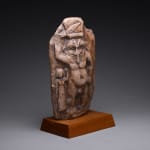Egyptian Sandstone Figure of the God Bes, 650 BCE - 300 BCE
Sandstone
height 26.7 cm
height 10 1/2 in
height 10 1/2 in
DJ.1048
Further images
This arresting sandstone sculpture of an obese homunculus is in fact a Late Dynastic period representation of the god Bes (or Bisu). He is shown in traditional, and even somewhat...
This arresting sandstone sculpture of an obese homunculus is in fact a Late Dynastic period representation of the god Bes (or Bisu). He is shown in traditional, and even somewhat exaggerated style, standing full square with his right arm raised and his left gripping the neck of a snake. His face is positively demonic, with pouchy cheeks, protuberant eyes, a snub nose and a host of accessory features that lends him an appearance that stands alone in the Egyptian pantheon.
Bes is a domestic god, who eventually moved on from the protection of houses, women, children and general domesticity to being the embodiment of good and the enemy of evil. He is usually shown in his role as a protector, strangling snakes (cats performed a similar function, and his name springs from the Nubian word for cat [besa]) and often surrounded by women or children. His origin is uncertain, although earlier research claiming a Nubian ancestry have been repudiated by later work indicating that he is in fact a product of Old/Middle Kingdom Egyptian culture. His cult, however, did not rise to prominence until well into the New Kingdom and the Late Period. Recent research indicates that his original representation was that of a lion rearing up on its hind legs, which partly explains his peculiar appearance.
Finally, he was a popular god because he was amusing and unthreatening, a far remove from the more markedly austere gods of the Old and Middle kingdoms, which were considerably less amicable in appearance and reputation. He is also known as a comic dwarf god that brings good luck and happiness to homes. He was even used as a tattoo motif, appearing on the thighs of dancers, musicians and servant girls during the New Kingdom. His popularity led him to be exported overseas, where he became a deity for the Phoenicians and Cypriots.
This is a charming and attractive piece of ancient art which would be equally at home in a collection or sophisticated domestic environment, which, in fact, he was designed to protect.
Bes is a domestic god, who eventually moved on from the protection of houses, women, children and general domesticity to being the embodiment of good and the enemy of evil. He is usually shown in his role as a protector, strangling snakes (cats performed a similar function, and his name springs from the Nubian word for cat [besa]) and often surrounded by women or children. His origin is uncertain, although earlier research claiming a Nubian ancestry have been repudiated by later work indicating that he is in fact a product of Old/Middle Kingdom Egyptian culture. His cult, however, did not rise to prominence until well into the New Kingdom and the Late Period. Recent research indicates that his original representation was that of a lion rearing up on its hind legs, which partly explains his peculiar appearance.
Finally, he was a popular god because he was amusing and unthreatening, a far remove from the more markedly austere gods of the Old and Middle kingdoms, which were considerably less amicable in appearance and reputation. He is also known as a comic dwarf god that brings good luck and happiness to homes. He was even used as a tattoo motif, appearing on the thighs of dancers, musicians and servant girls during the New Kingdom. His popularity led him to be exported overseas, where he became a deity for the Phoenicians and Cypriots.
This is a charming and attractive piece of ancient art which would be equally at home in a collection or sophisticated domestic environment, which, in fact, he was designed to protect.





